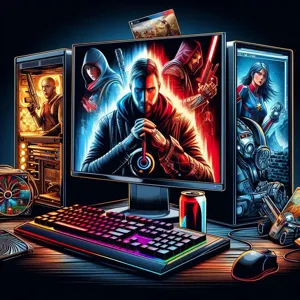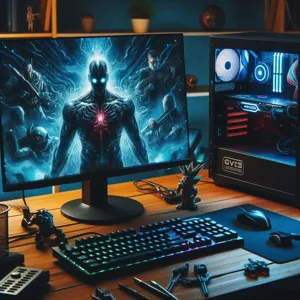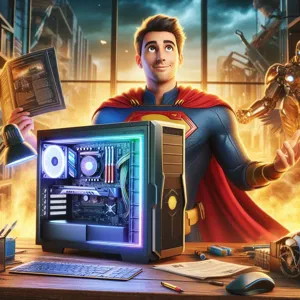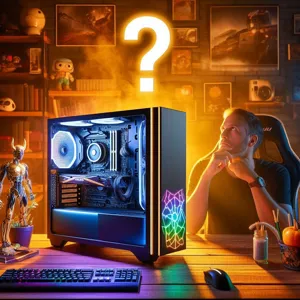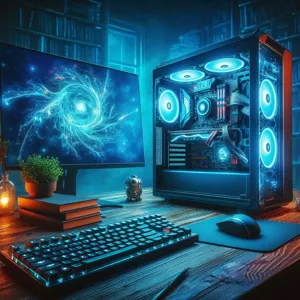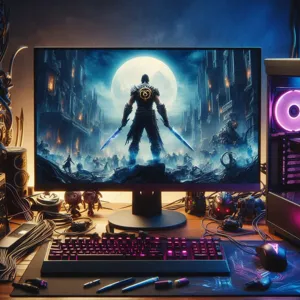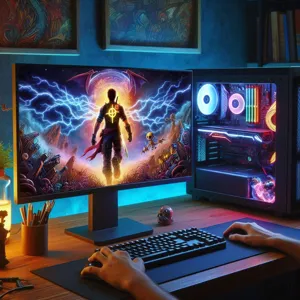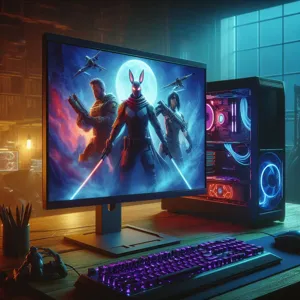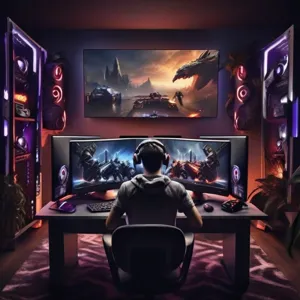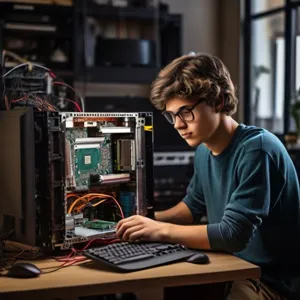In the ever-evolving world of gaming, where split-second decisions can determine victory or defeat, having an optimized PC can mean the difference between an exhilarating gaming experience and frustrating lag.
Whether you’re a casual gamer or a serious competitor, your hardware’s performance can significantly impact your gameplay. From adjusting graphics settings for stunning visuals without sacrificing frame rates to fine-tuning system preferences for seamless multitasking, every tweak counts. In this comprehensive guide, we will explore the essential settings and configurations to unlock your PC’s full potential, ensuring you achieve peak performance in your favorite games. Get ready to dive deep into the world of optimization, where each adjustment can elevate your gaming experience to new heights and help you dominate the competition.
1. Introduction to Peak Performance in Gaming

In the ever-evolving landscape of gaming, achieving peak performance is not just an advantage; it’s a necessity. As technology continues to advance, games have become increasingly demanding, pushing the limits of our hardware. Whether you’re diving into sprawling open-world adventures, engaging in fast-paced first-person shooters, or exploring intricate role-playing games, the difference between victory and defeat often hinges on the performance of your PC.
Peak performance in gaming refers to the optimal functioning of your computer’s hardware and software, working in unison to deliver a seamless, immersive experience. This means not only maintaining high frame rates and quick load times but also ensuring that your system runs smoothly without glitches, stuttering, or overheating. The goal is to immerse yourself fully in the game without distractions, allowing your skills and strategies to shine through.
But how do you achieve this coveted state of peak performance? It begins with understanding your PC’s capabilities and making the right adjustments. From fine-tuning graphics settings to optimizing system resources, there are a plethora of tweaks and strategies you can implement. In this guide, we will explore the essential steps to transform your gaming rig into a powerhouse that can handle the latest titles with ease, ensuring that you stay ahead of the competition and fully enjoy every moment of your gaming journey. Get ready to unlock your PC’s true potential and elevate your gaming experience to new heights!
2. Understanding Your System Specifications
Before diving into the intricate world of optimizing your PC for gaming, it’s crucial to understand the specifications of your system. Think of your computer as a finely-tuned race car; each component plays a vital role in ensuring peak performance on the gaming track. Knowing what you have under the hood will not only help you identify potential bottlenecks but also empower you to make informed decisions about upgrades and settings adjustments.
Start by checking your CPU, GPU, and RAM specifications. The CPU (Central Processing Unit) is the brain of your operation, dictating how quickly your system can process tasks. A powerful CPU can handle complex calculations and multitasking, which is essential for modern gaming. Next, turn your attention to the GPU (Graphics Processing Unit), the heart of your gaming experience. This component renders the graphics you see on screen, and a high-quality GPU can significantly enhance your visual experience, providing smoother frame rates and stunning graphics.
Don’t overlook your RAM (Random Access Memory), either. This is your system’s short-term memory, responsible for storing data that your CPU needs to access quickly. More RAM can support better multitasking and improve overall system performance, especially in memory-intensive games.
To find out your specifications, you can use built-in tools like windows’ Device Manager or third-party applications like CPU-Z and GPU-Z. Understanding these specs will give you insight into what games your system can handle and where potential upgrades may be needed to achieve the ultimate gaming experience.
Once you have a clear picture of your system’s specifications, you’ll be better equipped to make adjustments and optimizations that align with your gaming needs. Whether you’re looking to enhance performance or improve graphics quality, knowledge is your most powerful tool.
3. Updating Drivers for Optimal Performance
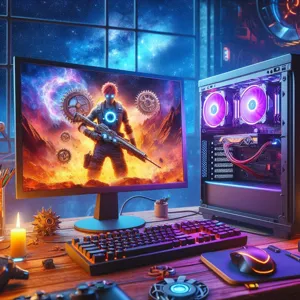
When it comes to gaming, having the latest drivers installed is akin to ensuring your vehicle runs on premium fuel—it’s essential for peak performance. Drivers serve as the bridge between your operating system and your hardware, translating commands into action. Outdated drivers can lead to a myriad of problems, from poor frame rates to unexpected crashes, all of which can derail your gaming experience.
To get started, you’ll want to identify which components of your PC require updates. The most critical drivers for gaming include those for your graphics card, sound card, and motherboard. Manufacturers like NVIDIA, AMD, and Intel frequently release updates to optimize performance and fix bugs, so checking their websites or using dedicated software can streamline this process.
Once you’ve pinpointed the drivers that need updating, download the latest versions directly from the manufacturer’s site. This ensures you’re getting the most stable and optimized software available. After installation, don’t forget to restart your PC. This simple step often consolidates the updates and maximizes your system’s potential.
Moreover, consider scheduling regular checks for driver updates. There are tools available that can notify you of new releases, allowing you to stay ahead of the curve. By investing a little time in keeping your drivers up to date, you can unlock a smoother, more immersive gaming experience, ensuring that your system performs at its absolute best while you dive into your favorite virtual worlds.
4. Configuring Windows Settings for Gaming
When it comes to optimizing your PC for gaming, the right Windows settings can make all the difference. An array of built-in features and adjustments can help streamline performance, reduce lag, and enhance your overall gaming experience. Here’s how to configure your Windows settings for maximum gaming success.
**Game Mode Activation**: Start by enabling Game Mode, a feature designed to prioritize your gaming experience. Navigate to Settings > Gaming > Game Mode and toggle it on. This will allocate more system resources to your game, ensuring smoother gameplay and fewer interruptions.
**Graphics Settings**: Next, dive into the Graphics Settings under Settings > System > Display. Here, you can specify which applications use the high-performance GPU versus integrated graphics. For your most demanding games, select the high-performance option to ensure they run at their best.
**Power Plan Optimization**: Your power settings play a crucial role in performance. Switch to a High-Performance power plan by going to Control Panel > Power Options and selecting the High-Performance option. This setting minimizes power-saving features that can throttle performance, allowing your system to run at full capacity during intense gaming sessions.
**Background Apps Management**: An often-overlooked aspect of performance optimization is managing background applications. Head to Settings > Privacy > Background Apps and disable any unnecessary apps that run in the background. This frees up valuable resources for your gaming experience, reducing the chance of lag or stuttering during critical moments.
**Disabling Full-Screen Optimizations**: Some games can benefit from disabling full-screen optimizations. Right-click on the executable file for your game, select Properties, navigate to the Compatibility tab, and check the box for “Disable fullscreen optimizations.” This can lead to a more stable and responsive gaming experience.
**Windows Updates**: Lastly, keep your Windows OS updated. While updates can sometimes seem like a nuisance, they often include performance improvements and security patches that can enhance your gaming experience. Schedule regular updates, but consider doing so during off-hours to prevent interruptions during your gaming sessions.
By taking the time to tweak these Windows settings, you’re setting the stage for peak performance in your gaming endeavors. With a few adjustments, your PC can transform into a finely tuned gaming machine, ready to tackle even the most demanding titles with ease.
5. Adjusting Graphics Settings in Games
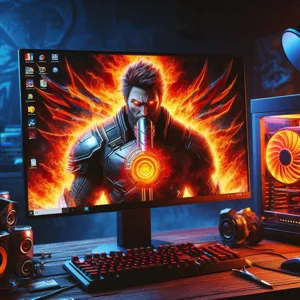
When it comes to optimizing your gaming experience, adjusting the graphics settings in your games can make a world of difference. While modern games often come equipped with stunning visuals and intricate details, these can put a significant strain on your PC’s hardware, potentially hindering performance. The key is to find the sweet spot between visual fidelity and frame rate—ensuring that you not only enjoy breathtaking graphics but also smooth gameplay.
Start by launching your game and navigating to the graphics settings menu. Here, you’ll typically encounter a plethora of options, ranging from resolution and texture quality to shadow detail and anti-aliasing. If you’re aiming for maximum performance, consider lowering the resolution a notch. While it may sacrifice some visual sharpness, the increase in frame rates can be substantial, leading to a more fluid gaming experience.
Texture quality is another critical setting to tweak. High-resolution textures can enhance the visual appeal of a game, but they also require more VRAM. If you notice stuttering or lag, consider setting this to medium or high instead of ultra. Similarly, shadows can drastically impact performance—reducing shadow quality or turning off dynamic shadows altogether can free up valuable resources without significantly detracting from immersion.
Don’t forget about anti-aliasing, a setting designed to smooth out jagged edges. While options like FXAA or TAA provide a cleaner look, they also demand more processing power. For competitive gaming, you might want to disable or lower this setting to gain an edge in responsiveness.
Lastly, take advantage of presets. Most games offer predefined settings for low, medium, high, or ultra graphics. These can serve as a helpful starting point, allowing you to gauge performance before making additional adjustments.
By thoughtfully tweaking your graphics settings, you can strike the perfect balance between visual appeal and gaming performance, unlocking the full potential of your gaming rig. Whether you’re exploring vast open worlds or battling it out in high-stakes arenas, optimized graphics settings will ensure your gaming sessions are not only enjoyable but also responsive and immersive.
6. Overclocking Your GPU and CPU Safely
Overclocking your GPU and CPU can be a thrilling way to unlock the full potential of your gaming rig, pushing performance beyond standard specifications. However, this process is not without risks, and it’s essential to approach it with caution to ensure that your components remain safe while delivering enhanced performance.
Before embarking on your overclocking journey, start by familiarizing yourself with the specifications and capabilities of your hardware. Each GPU and CPU has its own limits, and exceeding these can lead to overheating and potential damage. Begin by researching the optimal overclocking ranges for your specific model, paying close attention to temperature thresholds and voltage limits.
Once you have a solid understanding of your hardware, install reliable monitoring software to keep an eye on your system’s temperature and performance metrics. Tools like MSI Afterburner for GPUs and CPU-Z for CPUs are excellent choices for real-time tracking. This will allow you to monitor your system’s stability and temperature as you make adjustments.
Next, you can start the overclocking process by gradually increasing the clock speeds. Make small increments—typically 5-10%—and test the stability of your system after each adjustment. Run demanding applications or benchmark tests to ensure that your system can handle the new settings without crashing or showing signs of instability.
Cooling is paramount during this process. Consider upgrading your cooling system if you haven’t already, whether it’s through better air coolers, liquid cooling solutions, or even improved case ventilation. Keeping your components cool will not only enhance performance but also extend the lifespan of your hardware.
Lastly, document your settings and the corresponding performance results. This will help you find the sweet spot between performance and stability, allowing you to enjoy an optimal gaming experience. Remember, the goal of overclocking is to achieve better performance without sacrificing the integrity of your components, so err on the side of caution and prioritize safe practices throughout the process.
By following these guidelines, you can safely overclock your GPU and CPU, unlocking a new level of performance that will elevate your gaming sessions to new heights. Get ready to experience smoother frame rates, faster load times, and an overall enhanced gaming experience!
7. Managing Background Applications and Processes

Managing background applications and processes is a crucial step in optimizing your PC for a seamless gaming experience. Every gamer knows the frustration of lag or stuttering gameplay, and often, the culprit lies in the multitude of programs quietly running in the background, siphoning away your system’s resources.
Before launching your favorite game, take a moment to check what’s running on your PC. Press `Ctrl + Shift + Esc` to open the Task Manager, where you can view a list of active processes. Look for any unnecessary applications consuming CPU or memory. Applications like web browsers, cloud storage services, or even music streaming platforms can hog valuable resources and degrade your gaming performance.
To elevate your gaming experience, prioritize your gameplay by closing non-essential programs. If you need to keep certain applications open, consider using performance-oriented settings. For instance, if you rely on Discord for voice chat, adjust its settings to minimize its impact on your system. You can also set the Discord application to run in “Low Priority” mode, ensuring it doesn’t interfere with your game’s performance.
Additionally, you can disable startup programs that automatically launch when you power on your PC. This will not only speed up your boot time but also free up resources for when you dive into your gaming sessions. Navigate to the Startup tab in the Task Manager to manage which programs you want to disable.
Lastly, consider using tools like Game Mode in Windows 10 and 11, which optimizes your system for gaming by reallocating resources and preventing background applications from interfering. By effectively managing your background applications and processes, you can create a more streamlined and responsive gaming environment, keeping you immersed in your virtual adventures without the hindrances of sluggish performance.
8. Optimizing Storage: SSD vs. HDD
When it comes to gaming, the type of storage you choose can significantly impact your overall experience. Understanding the differences between Solid State drives (SSD) and Hard Disk Drives (HDD) is crucial for optimizing your PC settings and achieving peak performance.
**SSD (Solid State drive)**
SSDs are the champions of speed. Unlike traditional HDDs that use spinning disks to read and write data, SSDs utilize flash memory, which allows for lightning-fast access times. This means shorter load times for games, quicker boot-up sequences, and a more responsive system overall. Imagine launching your favorite game and being greeted with the main menu almost instantaneously—this is the power of an SSD. Not only do they enhance performance, but SSDs are also more durable, as they have no moving parts, making them less susceptible to physical damage.
**HDD (Hard Disk Drive)**
On the other hand, HDDs provide a cost-effective solution for gamers who require extensive storage without breaking the bank. With larger capacities at a fraction of the price per gigabyte compared to SSDs, HDDs are ideal for storing vast libraries of games, especially those that occupy significant disk space. While they may not offer the speed of SSDs, modern HDDs can still deliver satisfactory performance for many games, particularly if you’re not concerned with ultra-fast load times.
**The Best of both Worlds**
For gamers looking to optimize their storage solution, a hybrid approach often works best. Utilizing an SSD for your operating system and frequently played games can drastically reduce load times and enhance your gaming experience. Meanwhile, an HDD can serve as a secondary storage solution for less frequently accessed titles and large files, ensuring you have ample space without compromising on speed where it matters most.
Ultimately, the choice between SSD and HDD boils down to your gaming habits and budget. If you crave speed and responsiveness, an SSD is the way to go. However, if you’re looking to build a robust game library without the financial strain, an HDD can still provide solid performance. By carefully considering your storage options, you can significantly elevate your gaming experience and unlock your PC’s full potential.
9. Utilizing Game Mode in Windows
When it comes to gaming on a PC, every frame counts, and that’s where Windows’ Game Mode comes into play. This built-in feature is designed to prioritize your gaming experience by reallocating system resources and optimizing performance. To access Game Mode, simply navigate to the Settings menu, click on “Gaming,” and toggle the Game Mode switch to the “On” position.
Once activated, Game Mode works its magic by minimizing background processes and preventing unnecessary notifications, allowing your system to devote more power to the game at hand. This means smoother gameplay, reduced lag, and an overall enhanced gaming experience. Notably, Game Mode can also boost frame rates and improve responsiveness, which is crucial for competitive gaming scenarios where every millisecond matters.
Additionally, Game Mode helps maintain consistent performance by automatically adjusting settings for each game you play. For instance, it can optimize graphics settings based on your hardware capabilities and even record gameplay without causing significant performance drops. This feature is particularly useful for streamers and content creators looking to capture high-quality footage while playing.
To make the most of Game Mode, consider pairing it with other optimization techniques, such as updating your graphics drivers and managing your startup programs. Together, these steps can significantly enhance your gaming performance, providing an edge in your favorite titles. So, whether you’re diving into a fast-paced shooter or exploring vast open worlds, activating Game Mode is a simple yet powerful way to ensure your gaming sessions are as seamless and enjoyable as possible.
10. Enhancing Network Settings for Online Gaming
When it comes to online gaming, a stable and fast internet connection can make all the difference between victory and defeat. Enhancing your network settings is crucial for minimizing latency and ensuring a smooth gaming experience. Here are some key steps to optimize your network for peak performance.
First, consider your router’s placement. Ideally, your router should be centrally located in your home, away from obstructions and electronic devices that may cause interference. Elevating it on a shelf or mounting it on a wall can help improve signal strength. If possible, connect your gaming PC directly to the router using an Ethernet cable. Wired connections offer lower latency and more reliable speeds than Wi-Fi, making them the preferred choice for competitive gaming.
Next, take advantage of Quality of Service (QoS) settings in your router. QoS allows you to prioritize bandwidth for your gaming device, ensuring that it receives the necessary resources even when other devices are using the network. By allocating higher priority to your gaming traffic, you can reduce lag and improve responsiveness during intense gaming sessions.
Additionally, consider adjusting the MTU (Maximum Transmission Unit) settings on your router. Lowering your MTU size can help reduce packet fragmentation, which often leads to lag. Generally, an MTU size of around 1472 is a good place to start, but testing various sizes to find the optimal setting for your connection may yield better results.
Finally, keep your network firmware up to date. Manufacturers regularly release updates to improve performance and security. Regularly checking for these updates ensures that your router is running efficiently and can handle the demands of modern online gaming.
By taking these steps to enhance your network settings, you’ll be well on your way to unlocking your gaming potential. A robust, low-latency internet connection sets the stage for an immersive and competitive gaming experience, allowing you to focus on what really matters—dominating the battlefield!
11. Cooling Solutions: Keeping Your PC Temperate
When it comes to gaming, performance isn’t just about having the latest hardware; it’s also about maintaining an optimal environment for that hardware to thrive. One of the critical aspects often overlooked is cooling. A well-cooled PC not only enhances performance but also prolongs the lifespan of your components, ensuring that you can keep your gaming rig running at peak efficiency for years to come.
First, consider investing in a quality cooling solution. Air coolers are a popular choice for their balance of cost and efficiency, but if you’re looking for something more robust, liquid cooling systems can deliver significantly lower temperatures. These systems, whether custom-built or all-in-one units, circulate coolant through a series of tubes and radiators, drawing heat away from key components like the CPU and GPU. This not only keeps temperatures down but can also create a visually stunning centerpiece for your gaming setup.
Moreover, don’t underestimate the importance of case airflow. Ensure your PC case has an adequate number of fans for optimal air circulation. Position intake fans at the front and bottom of the case to pull cool air in while exhaust fans at the top and rear expel hot air out. This creates a constant flow of air that helps dissipate heat efficiently.
Additionally, keep an eye on dust buildup. Over time, dust can accumulate and clog fans and vents, significantly reducing cooling efficiency. Regularly cleaning your components and ensuring that airflow isn’t obstructed can make a world of difference. You might even consider adding dust filters to your case, which can help keep your internals clean while maintaining airflow.
Finally, don’t forget about monitoring your temperatures. Use software tools to track the heat levels of your CPU, GPU, and other critical components. This will help you identify any potential overheating issues before they become a problem, allowing you to take action, whether it’s adjusting fan speeds or improving case ventilation.
By implementing effective cooling solutions and maintaining a clean, well-ventilated environment, you can ensure your PC remains at a stable temperature, allowing you to enjoy an uninterrupted gaming experience without the fear of thermal throttling or hardware damage. Unlock the full potential of your gaming rig by keeping it cool—after all, a comfortable PC is a high-performing PC.
12. Regular Maintenance and Cleanup Tips
To achieve peak performance in gaming, regular maintenance and cleanup of your PC is essential. Over time, files accumulate, software becomes cluttered, and your system can slow down if not properly managed. Here are some vital tips to keep your gaming rig running smoothly and efficiently.
First and foremost, make it a habit to routinely delete unnecessary files. Temporary files, downloads, and unused applications can take up valuable storage space and affect your system’s speed. Utilize built-in tools like Disk Cleanup on Windows or third-party applications, such as CCleaner, to automate this process and free up disk space.
Next, don’t overlook the importance of updating your drivers, especially your graphics card drivers, which can significantly impact gaming performance. Keeping them updated ensures you have access to the latest optimizations and features. Most manufacturers provide easy-to-use utilities that can automatically check for updates, making this task simpler than ever.
Additionally, regularly defragmenting your hard drive (for HDD users, as SSDs don’t require this) can improve data retrieval speeds. Fragmentation can scatter files around your hard drive, leading to longer load times. Tools like Windows’ built-in defragmentation utility can streamline this process, ensuring your data is stored in an optimal manner.
Lastly, consider dusting out your hardware. Dust buildup can cause overheating, which leads to throttling and performance drops during demanding gaming sessions. Opening up your case to carefully clean fans and components or investing in a can of compressed air can help maintain optimal temperatures and enhance overall performance.
By incorporating these regular maintenance and cleanup tips into your gaming routine, you can ensure that your PC runs at its best, allowing you to enjoy a smoother, more immersive gaming experience. Remember, a well-maintained system not only enhances performance but also extends the lifespan of your hardware, giving you more time to conquer virtual worlds!
13. Monitoring Performance with Benchmark Tools
To truly unlock the peak performance of your gaming rig, monitoring your system’s performance with benchmark tools is essential. These tools serve as your digital compass, guiding you through the vast landscape of CPU, GPU, and overall system health. By using benchmarking software, you can gain valuable insights into how your components are performing under various loads and conditions, allowing you to make informed decisions to enhance your gaming experience.
Popular benchmarking tools like 3DMark, Unigine Heaven, and UserBenchmark provide detailed metrics on frame rates, temperatures, and system bottlenecks. These applications simulate demanding scenarios to push your hardware to its limits, revealing how well it holds up under pressure. For instance, if you’re noticing stuttering during intense gameplay, a benchmarking tool can help you pinpoint whether your graphics card is underperforming or if your CPU is the real culprit.
Additionally, many of these tools offer comparative analysis features, enabling you to see how your setup stacks up against similar configurations or the latest technology on the market. This not only helps in assessing your current performance but also in planning future upgrades. By identifying weak points in your hardware, you can prioritize upgrades that will deliver the most significant impact on your gaming experience.
Regularly monitoring your system’s performance through benchmarking can also alert you to potential issues before they escalate. Sudden drops in frame rates or unusually high temperatures can indicate hardware malfunctions or the need for maintenance. Staying proactive with these insights ensures that you’re not just gaming, but gaming at your best.
Incorporating performance monitoring into your gaming routine empowers you to optimize settings, adjust overclocking profiles, and tweak game configurations for the smoothest experience possible. By leveraging the data from benchmark tools, you can fine-tune your PC’s performance, ensuring that every pixel and frame is rendered with precision as you dive into your favorite virtual worlds.
14. Exploring Additional Software for Optimization
When it comes to maximizing your gaming experience, the right software can make all the difference. While adjusting your PC settings is a crucial step, exploring additional software solutions can unlock even greater performance. Here’s a look at some powerful tools that can help you optimize your system for a smoother, more immersive gaming experience.
First on the list are **game optimization tools**, such as Razer Cortex or NVIDIA GeForce Experience. These programs are designed to automatically adjust your system settings and game configurations based on the hardware you have. Razer Cortex, for example, can help manage your game library, shut down unnecessary background processes, and even optimize your game’s settings for the best performance. GeForce Experience offers similar features, along with the added bonus of keeping your graphics drivers up to date, ensuring you’re always equipped with the latest enhancements and bug fixes.
Another category worth considering is **system monitoring software**. Tools like MSI Afterburner or HWMonitor allow you to keep tabs on your GPU and CPU temperatures, usage, and clock speeds in real-time. By monitoring this data, you can identify potential bottlenecks during gameplay and make informed adjustments to your overclocking settings or cooling solutions, which can enhance stability and performance.
Additionally, consider utilizing **game launchers** with built-in optimization features. Platforms like Steam and Epic Games Store often include options to verify game files and optimize settings based on your hardware. This can be an invaluable tool, especially if you encounter performance issues or crashes.
Lastly, don’t overlook the importance of system cleanup and maintenance software. Programs like CCleaner can help you clear out unnecessary files, manage startup programs, and keep your system running smoothly. A clean system is a faster system, and this can greatly enhance your gaming experience.
By exploring and integrating these additional software options into your gaming setup, you can fine-tune your PC’s performance, ensuring you’re always ready to tackle the latest titles with the speed and efficiency they demand. With the right combination of settings and software, you’ll be well on your way to unlocking peak gaming performance.
15. Conclusion: Finding the Right Balance for Your Gaming Experience
In the realm of gaming, achieving peak performance often hinges on the delicate balance between hardware capabilities and software settings. As we’ve explored throughout this guide, optimizing your PC settings can significantly enhance your gaming experience, but it’s vital to remember that each gamer’s needs and preferences are unique.
Striking the right balance means understanding the interplay between graphics quality, frame rates, and system performance. High-resolution textures and stunning visuals can be immersive, but they may come at the cost of smooth gameplay if your hardware isn’t up to par. Conversely, cranking down the graphics settings can lead to buttery smooth performance, but at the expense of visual fidelity.
It’s also important to consider personal preferences; some gamers prioritize competitive edge and fluidity, while others revel in the artistry of game design. As you navigate through your optimization journey, take the time to experiment with different settings to discover what feels right for you.
Moreover, don’t forget to keep your system updated and clean from unnecessary bloatware that can hinder performance. Regularly checking for driver updates and conducting routine maintenance will ensure your PC runs at its best, providing a seamless experience that allows you to fully immerse yourself in the worlds you love.
In conclusion, optimizing your PC for gaming is not a one-size-fits-all approach. It’s about finding that sweet spot where performance meets personal enjoyment. By fine-tuning your settings and staying attuned to your hardware’s capabilities, you’ll unlock the full potential of your gaming rig and elevate your gaming sessions to new heights. Happy gaming!
In conclusion, optimizing your PC settings for gaming success is not just about enhancing performance; it’s about creating an immersive experience that allows you to fully enjoy the games you love. By following the tips and strategies outlined in this post, from updating drivers and adjusting graphics settings to managing background processes and ensuring proper cooling, you can unlock your PC’s full potential. As you implement these changes, you’ll not only notice smoother gameplay and improved frame rates, but you’ll also gain a competitive edge that can elevate your gaming sessions to new heights. So gear up, dive into your favorite titles, and enjoy the thrilling adventures that await you with your newly optimized gaming setup. Happy gaming!



